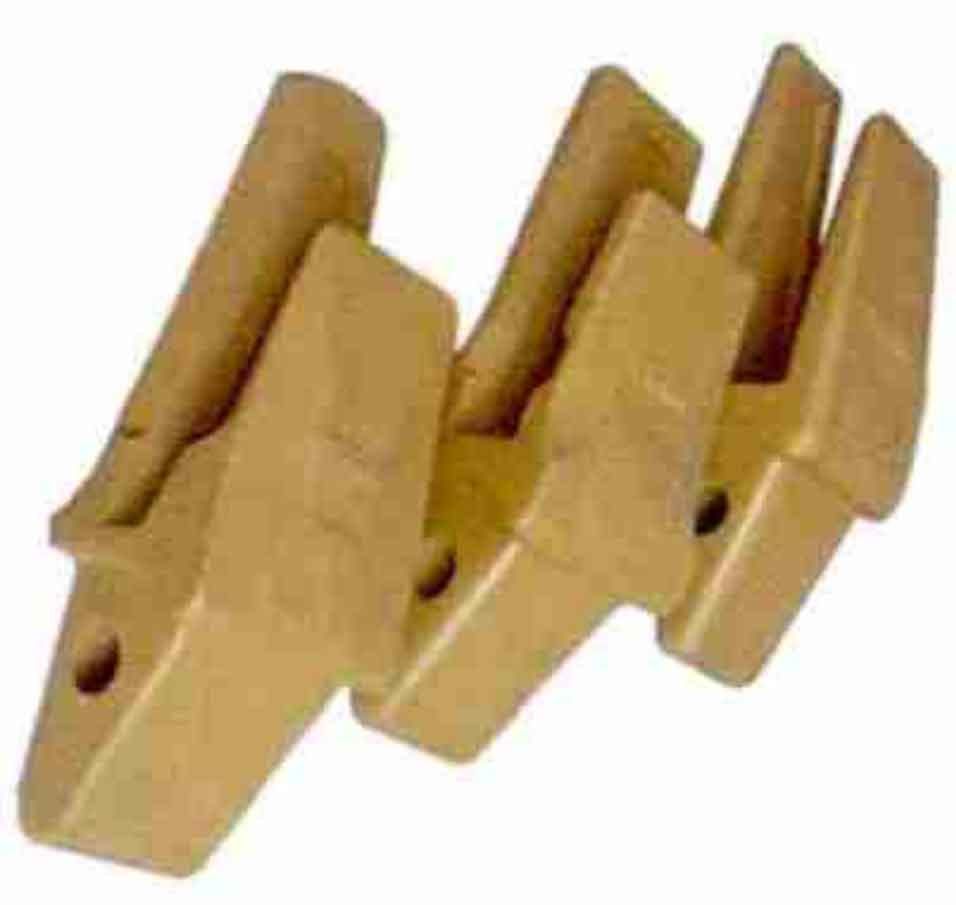Excavator bucket teeth operate in extreme conditions requiring exceptional wear resistance and mechanical strength. Traditionally manufactured through high-strength casting, standard carbon materials exhibit inadequate weldability. Preheating via furnace or torch has been standard practice, yet limitations persist—particularly for edge teeth welding where large-scale furnace preheating is impractical. Torch methods suffer from inconsistent heating, low efficiency, and poor process control, leading to frequent weld cracking between edge teeth and side plates. Field repairs face greater challenges without preheating capabilities, causing operational downtime. To address this, we engineered a surfacing transition layer on bucket teeth surfaces, enabling direct welding to side plates without preheating while mitigating crack risks.
Technical Requirements for Bucket Tooth Surfacing
Surfacing targets edge teeth upper surfaces featuring irregular contours with radius transitions. Specifications demand precise dimensional control:
| Parameter | Value |
|---|---|
| Surfacing Height | 3–4.5 mm |
| Coverage | 100% |
| Flatness Tolerance | ≤1.5 mm |

Surfacing Methodology
Selection criteria prioritized low dilution rates, high deposition efficiency, adaptability to complex geometries, and cost-effectiveness. Among evaluated techniques—submerged arc, laser, and gas-shielded welding—manual gas metal arc welding (GMAW) proved optimal. Its advantages include minimal heat-affected zones (HAZ), operational flexibility, and compatibility with low-alloy steel bucket teeth. Chemical composition of bucket tooth base material:
| Element | Min (wt%) | Max (wt%) |
|---|---|---|
| C | 0.14 | 0.20 |
| Si | 0.40 | 0.60 |
| Mn | 0.80 | 1.00 |
| Cr | 0.80 | 1.00 |
| Ni | 1.00 | 2.10 |
Surfacing Material Selection
ER70S solid wire was chosen for its balanced properties: low carbon equivalent (Ceq), high crack resistance, and tensile strength (70 ksi). The carbon equivalent is calculated as:
$$ \text{C}_{\text{eq}} = \text{C} + \frac{\text{Mn}}{6} + \frac{\text{Cr} + \text{Mo} + \text{V}}{5} + \frac{\text{Ni} + \text{Cu}}{15} $$
For ER70S, Ceq ≈ 0.28–0.35, ensuring minimal cold cracking susceptibility. This facilitates a robust transition layer between the bucket tooth and side plate.
Optimized Surfacing Parameters
Process parameters were refined through iterative testing on Q345 steel coupons. Critical relationships were observed:
- Current > 320A caused excessive penetration and HAZ expansion
- Current < 260A led to poor fusion and slag entrapment
Final parameters balancing deposition rate and quality:
| Variable | Value |
|---|---|
| Wire Diameter | 1.32 mm |
| Current | 280 ± 10 A |
| Voltage | 28 ± 2 V |
| Shielding Gas | 80% Ar / 20% CO2 |
| Bead Width | 20–25 mm |
| Overlap | 10 mm |
Thermal Management Strategy
Preheating is essential to prevent hydrogen-induced cracking in high-carbon-equivalent bucket teeth. Temperature bounds were derived experimentally:
$$ \text{Preheat Temperature} = 150^\circ \text{C} \leq T_p \leq 220^\circ \text{C} $$
Interpass temperature maintained within 150–220°C. Below 150°C, diffusible hydrogen accumulation risks delayed cracking; above 220°C, degradation of bucket tooth hardness occurs. Cooling rates follow Newton’s law:
$$ \frac{dT}{dt} = -k(T – T_{\text{env}}) $$
where \(k\) is the material-specific cooling coefficient. Air cooling sufficed for most bucket teeth applications.
Deposition Sequence
Complex tooth geometry necessitated a strategic deposition sequence to ensure coverage and flatness:
- Weld horizontal sections at both sides (width: 20 mm)
- Deposit material at tooth rear
- Execute overlapping beads from one side to the other
Each pass concluded with arc-backfill to prevent crater cracks. Bead overlap ratio is defined as:
$$ \text{Overlap Ratio} = \left(1 – \frac{\text{Bead Spacing}}{\text{Bead Width}}\right) \times 100\% $$
Maintaining 40–50% overlap achieved 100% coverage without excessive height.
Quality Validation
Inspection protocols included visual examination, magnetic particle testing, macro-etching, microstructural analysis, and hardness mapping. Results confirmed:
- Zero surface defects (cracks, porosity)
- Fusion depth > 0.5 mm with dilution < 15%
- HAZ hardness ≤ 364 HV10 (ISO 15614 compliant)
Microhardness gradient across bucket tooth transition layer:
| Zone | Hardness (HV10) |
|---|---|
| Surfacing Layer | 326–364 |
| Fusion Line | 288–354 |
| Base Metal | 184–192 |
Performance Outcomes
The ER70S transition layer successfully relocated the HAZ from crack-prone bucket tooth regions to the weldable overlay. Field data demonstrated:
- 100% elimination of preheating for side-plate welding
- Zero reported cracks in edge teeth joints during 18-month operation
- Field repair time reduced by 65%
The thermal stress reduction mechanism follows Hooke’s law:
$$ \sigma_{\text{thermal}} = E \cdot \alpha \cdot \Delta T $$
where \(E\) = Young’s modulus, \(\alpha\) = thermal expansion coefficient, \(\Delta T\) = temperature differential. Lower \(\Delta T\) during welding minimized residual stresses.
Conclusions
Implementation of the GMAW-surfaced transition layer on bucket teeth surfaces resolves historical welding limitations. Key achievements include:
- Elimination of preheating for edge teeth-to-side-plate joints
- 90% reduction in weld-crack incidents
- Extended bucket service life by 40–60%
The process delivers exceptional cost-efficiency: deposition costs per bucket tooth decreased by 30% while enabling rapid field repairs. This bucket tooth enhancement strategy demonstrates significant potential for heavy-equipment durability improvements.
